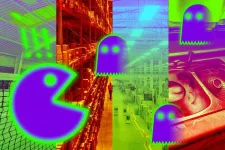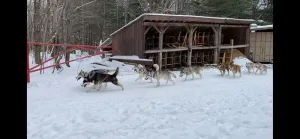(Press-News.org) Across cosmic history, powerful forces have acted on matter, reshaping the universe into an increasingly complex web of structures.
Now, new research led by Joshua Kim and Mathew Madhavacheril at the University of Pennsylvania and their collaborators at Lawrence Berkeley National Laboratory suggests our universe has become “messier and more complicated” over the roughly 13.8 billion years it’s been around, or rather, the distribution of matter over the years is less “clumpy” than expected.
“Our work cross-correlated two types of datasets from complementary, but very distinct, surveys,” says Madhavacheril, “and what we found was that for the most part, the story of structure formation is remarkably consistent with the predictions from Einstein’s gravity. We did see a hint for a small discrepancy in the amount of expected clumpiness in recent epochs, around four billion years ago, which could be interesting to pursue.”
The data, published in the Journal of Cosmology and Astroparticle Physics and the preprint server arXiv, comes from the Atacama Cosmology Telescope’s (ACT) final data release (DR6) and the Dark Energy Spectroscopic Instrument’s (DESI) Year 1. Madhavacheril says that pairing this data allowed the team to layer cosmic time in a way that resembles stacking transparencies of ancient cosmic photographs over recent ones, giving a multidimensional perspective of the cosmos.
“ACT, covering approximately 23% of the sky, paints a picture of the universe’s infancy by using a distant, faint light that’s been travelling since the Big Bang,” says first author of the paper Joshua Kim, a graduate researcher in the Madhavacheril Group. “Formally, this light is called the Cosmic Microwave Background (CMB), but we sometimes just call it the universe’s baby picture because it’s a snapshot of when it was around 380,000 years old.”
The path of this ancient light throughout evolutionary time, or as the universe has aged, has not been a straight one, Kim explains. Gravitational forces from large, dense, heavy structures like galaxy clusters in the cosmos have been warping the CMB, sort of like how an image is distorted as it travels through a pair of spectacles. This “gravitational lensing effect,” which was first predicted by Einstein more than 100 years ago, is how cosmologists make inferences about its properties like matter distribution and age.
DESI’s data, on the other hand, provides a more recent record of the cosmos. Based in the Kitt Peak National Observatory in Arizona and operated by the Lawrence Berkeley National Laboratory, DESI is mapping the universe’s three-dimensional structure by studying the distribution of millions of galaxies, particularly luminous red galaxies (LRGs). These galaxies act as cosmic landmarks, making it possible for scientists to trace how matter has spread out over billions of years.
“The LRGs from DESI are like a more recent picture of the universe, showing us how galaxies are distributed at varying distances,” Kim says, likening the data to the universe’s high school yearbook photo. “It’s a powerful way to see how structures have evolved from the CMB map to where galaxies stand today.
By combining the lensing maps from ACT’s CMB data with DESI’s LRGs, the team created an unprecedented overlap between ancient and recent cosmic history, enabling them to compare early- and late-universe measurements directly. “This process is like a cosmic CT scan,” says Madhavacheril, “where we can look through different slices of cosmic history and track how matter clumped together at different epochs. It gives us a direct look into how the gravitational influence of matter changed over billions of years.”
In doing so they noticed a small discrepancy: the clumpiness, or density fluctuations, expected at later epochs didn’t quite match predictions. Sigma 8 (σ8), a metric that measures the amplitude of matter density fluctuations, is a key factor, Kim says, and lower values of σ8 indicate less clumping than expected, which could mean that cosmic structures haven’t evolved according to the predictions from early-universe models and suggest that the universe’s structural growth may have slowed in ways current models don’t fully explain.
This slight disagreement with expectations, he explains, “isn’t strong enough to suggest new physics conclusively—it’s still possible that this deviation is purely by chance.”
If indeed the deviation is not by chance, some unaccounted-for physics could be at play, moderating how structures form and evolve over cosmic time. One hypothesis is that dark energy—the mysterious force thought to drive the universe’s accelerating expansion—could be influencing cosmic structure formation more than previously understood.
Moving forward, the team will work with more powerful telescopes, like the upcoming Simons Observatory, which will refine these measurements with higher precision, enabling a clearer view of cosmic structures.
Mathew Madhavacheril is an assistant professor in the Department of Physics and Astronomy in the School of Arts & Sciences at the University of Pennsylvania.
Joshua Kim is a Ph.D. candidate at Penn Arts & Sciences.
The research was supported by Agencia Nacional de Investigación y Desarrollo (Basal project FB210003); Atacama Cosmology Telescope Project (Grants AST-0408698, AST-0965625, AST-1440226); Canada Foundation for Innovation; Cambridge International Trust; Chinese Academy of Sciences; Chinese National Natural Science Foundation; Dark Energy Spectroscopic Instrument Member Institutions; European Research Council (Grant No. 851274 and No. 849169); Fermi Research Alliance, (Contract No. DE-AC02-07CH11359); French Alternative Energies and Atomic Energy Commission; Fundación Mauricio y Carlota Botton; Gordon and Betty Moore Foundation; Heising-Simons Foundation; "la Caixa" Foundation; Lawrence Berkeley National Laboratory (Contract No. DE-AC02-05CH11231); NASA (Grants NNX13AE56G, NNX14AB58G, and 21-ATP21-0145); National Astronomical Observatories of China; National Council of Science and Technology of Mexico; National Energy Research Scientific Computing Center; National Research Foundation of South Africa; National Science Foundation (Grants AST-2307727, AST-2153201, PHY-0355328, PHY-0855887, PHY-1214379, AST-0950945, AST-2108126); Princeton University; Science and Technologies Facilities Council of the United Kingdom; Swiss National Science Foundation (Fellowship No. 186879); and the University of Pennsylvania.
END
A less ‘clumpy,’ more complex universe?
Researchers combined cosmological data from two major surveys of the universe’s evolutionary history and found that it may have become ‘messier and complicated’ than expected in recent years.
2025-01-29
ELSE PRESS RELEASES FROM THIS DATE:
New ways to modulate cell activity remotely
2025-01-29
Imagine being at a big marquee event at an arena, like the Super Bowl, with the roar of the crowd, the smell of hot dogs, and a sea of jerseys all merging into one chaotic blur. While the frenzied, exciting environment certainly enhances your viewing experience, it can also make it difficult to find the people you came with if you get separated. If you’re communicating by phone or waving from the stands, it can be an exhausting game of hide-and-seek amid the noise and commotion.
Now imagine if you had ...
Changing cholesterol over time tied to risk of dementia
2025-01-29
EMBARGOED FOR RELEASE UNTIL 4:00 P.M. ET, WEDNESDAY, JANUARY 29, 2025
MINNEAPOLIS — Older adults whose cholesterol changes over time may be more likely to develop dementia than people whose cholesterol is stable, regardless of the actual cholesterol level, according to a study published in the January 29, 2025, online issue of Neurology®, the medical journal of the American Academy of Neurology.
The study does not prove that changing cholesterol causes dementia; it only shows an association.
“These results suggest that fluctuating cholesterol, measured annually, may be a new biomarker for identifying ...
New training approach could help AI agents perform better in uncertain conditions
2025-01-29
CAMBRIDGE, MA – A home robot trained to perform household tasks in a factory may fail to effectively scrub the sink or take out the trash when deployed in a user’s kitchen, since this new environment differs from its training space.
To avoid this, engineers often try to match the simulated training environment as closely as possible with the real world where the agent will be deployed.
However, researchers from MIT and elsewhere have now found that, despite this conventional wisdom, sometimes training in a completely different environment yields a better-performing artificial intelligence agent.
Their results indicate that, in some situations, training a simulated ...
A window into the future of Amazonia
2025-01-29
It’s a place where few living things can survive in the water.
Deep in the world’s largest rainforest, there is a boiling river. Found in eastern central Peru, it is a small tributary that eventually leads to the Amazon River.
Heated by cracks in the Earth’s crust, at its warmest spots, the water can reach 200 degrees Fahrenheit, an inhospitable environment with air temperatures hotter than anywhere else in the Amazon.
But the steamy river, known locally as “Shanay-Timpishka,” which translates as “boiled with the heat of the ...
3D models of uveal melanoma offer hope for improved treatments
2025-01-29
ROCHESTER, Minnesota — Mayo Clinic researchers have developed organoid models to study uveal melanoma, one of the most common types of eye cancer in adults. Their goal is to use these models to better understand how this disease works and develop treatments for unmet patient needs.
Organoids are 3D models grown from patient tissue that accurately reflect a patient's unique genetic and biological characteristics, also known as "avatars." When derived from a patient's cancer tumor, an organoid will behave and respond to treatments outside the body in a lab (in vitro) just like the original tumor would inside the body (in vivo).
In 50% of patients, ...
Chemical looping turns environmental waste into fuel
2025-01-29
COLUMBUS, Ohio – Turning environmental waste into useful chemical resources could solve many of the inevitable challenges of our growing amounts of discarded plastics, paper and food waste, according to new research.
In a significant breakthrough, researchers from The Ohio State University have developed a technology to transform materials like plastics and agricultural waste into syngas, a substance most often used to create chemicals and fuels like formaldehyde and methanol.
Using simulations to test how well the system could break down waste, scientists found that their approach, called ...
Working dogs take a day to adjust to Daylight Savings Time, but pets are more flexible
2025-01-29
Working dogs take a day to adjust to the change in routine caused by Daylight Savings Time, whereas pet dogs and their owners seem to be unaffected, according to a study publishing January 29, 2025 in the open-access journal PLOS One by Lavania Nagendran, Ming Fei Li and colleagues at the University of Toronto, Canada.
Daylight Savings Time (DST) is used by many countries to maintain the alignment between daylight hours and human activity patterns, by setting clocks forward one hour in the spring and back one hour in the autumn. Previous research has shown that DST can disrupt ...
Reviews of movies with female- versus male-dominated casts found to contain more sexist language
2025-01-29
In a new linguistic analysis, reviews of movies with female-dominated casts were found to have significantly higher levels of sexism than reviews of movies with male-dominated casts. Jad Doughman and Wael Khreich of the American University of Beirut, Lebanon, present these findings in the open-access journal PLOS One, on January 29, 2025.
Prior research suggests that negative movie reviews can affect actors’ finances, career paths, and mental well-being, while also influencing the broader media landscape. However, studies of gender bias in reviews have traditionally relied on movie ratings or box-office ...
Women exercising in gyms often face barriers including body image and harassment
2025-01-29
When exercising in gyms, women face barriers across various domains, including physical appearance and body image, gym attire, the physical gym environment, and interactions with others, according to a study published January 29, 2025, in the open-access journal PLOS One by Emma Cowley from the SHE Research Centre, TUS, Ireland, and Jekaterina Schneider from the University of the West of England, U.K.
Exercise significantly improves physical, mental, and psychosocial health. Recent research indicates that women who engage in regular exercise experience greater health benefits than men, including lower incidence of all-cause mortality and reduced ...
SNU researchers apply the principles of mantis shrimp and fleas to create soft robots with powerful movements
2025-01-29
Seoul National University College of Engineering announced that a research team led by Professor Kyu-Jin Cho (Director of the Soft Robotics Research Center) from the Department of Mechanical Engineering took inspiration from principles found in nature and developed the "Hyperelastic Torque Reversal Mechanism (HeTRM)," which enables robots made from rubber-like soft materials to perform rapid and powerful movements. This study was published in the prestigious international journal Science Robotics on January 29.
The mantis shrimp delivers a punch ...
LAST 30 PRESS RELEASES:
Coffee as a staining agent substitute in electron microscopy
Revealing the diversity of olfactory receptors in hagfish and its implications for early vertebrate evolution
Development of an ultrasonic sensor capable of cuffless, non-invasive blood pressure measurement
Longer treatment with medications for opioid use disorder is associated with greater probability of survival
Strategy over morality can help conservation campaigns reduce ivory demand, research shows
Rising temperatures reshape microbial carbon cycling during animal carcass decomposition in water
Achieving ultra-low-power explosive jumps via locust bio-hybrid muscle actuators
Plant-derived phenolic acids revive the power of tetracycline against drug-resistant bacteria
Cooperation: A costly affair in bacterial social behaviour?
Viruses in wastewater: Silent drivers of pollution removal and antibiotic resistance
Sub-iethal water disinfection may accelerate the spread of antibiotic resistance
Three in four new Australian moms struggle with body image
Post-stroke injection protects the brain in preclinical study
Cardiovascular risk score predicts multiple eye diseases
Health: estimated one in ten British adults used or interested in GLP-1 medications for weight loss
Exercise to treat depression yields similar results to therapy
Whooping cough vaccination for pregnant women strengthens babies’ immune system
Dramatic decline in new cases of orphanhood in Uganda driven by HIV treatment and prevention programs
Stopping weight loss drugs linked to weight regain and reversal of heart health markers
Higher intake of food preservatives linked to increased cancer risk
Mass General Brigham–developed cholera vaccine completes phase 1 trial
First experimental validation of a “150-year-old chemical common sense” direct visualization of the molecular structural changes in the ultrafast anthracene [4+4] photocycloaddition reaction
Lack of support for people on weight loss drugs leaves them vulnerable to nutritional deficiencies, say experts
Dogs’ dinners can have greater climate impact than owners’
Are you ready to swap salmon for sprats and sardines?
1.6 million UK adults used weight loss drugs in past year
American College of Cardiology comments on new dietary guidelines for Americans
American Society of Gene & Cell Therapy and Orphan Therapeutics Accelerator partner to advance and commercialize promising rare disease treatments
One in 14 patients having day case surgery have new or worse chronic pain 3 months after their operation
New study highlights link between eviction rates and gun violence
[Press-News.org] A less ‘clumpy,’ more complex universe?Researchers combined cosmological data from two major surveys of the universe’s evolutionary history and found that it may have become ‘messier and complicated’ than expected in recent years.




